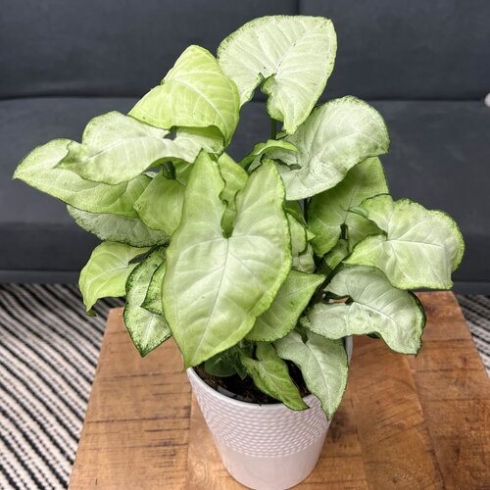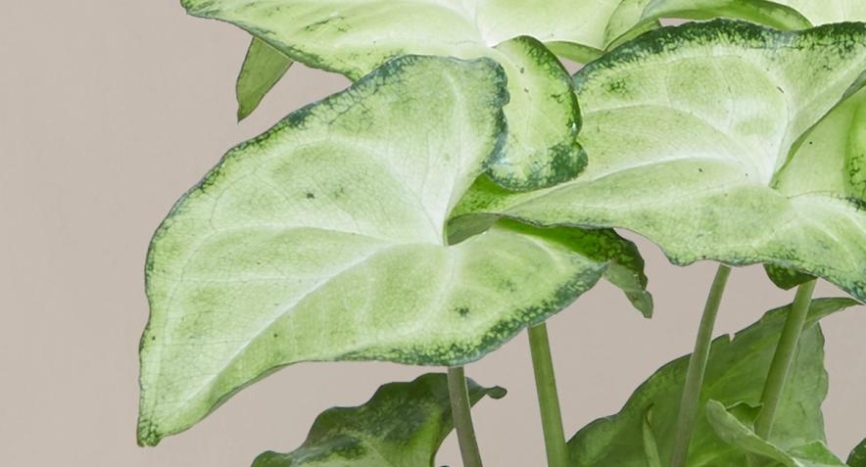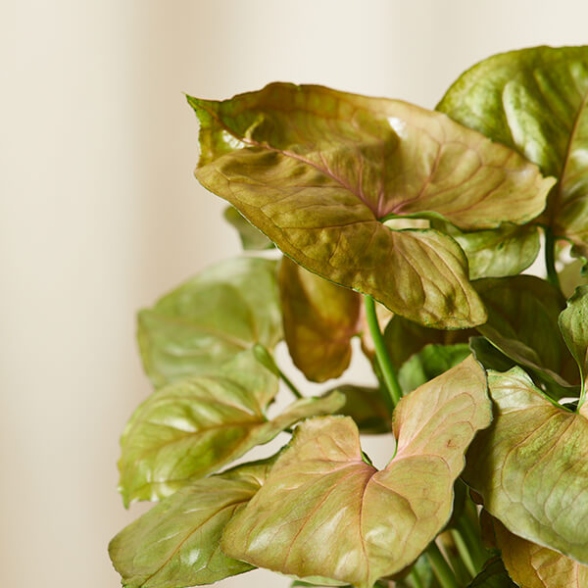Green Thumb Goals: Mastering Arrowhead Plant Care
Welcome to the ultimate guide to arrowhead plant care! If you’re looking to master the art of caring for these beautiful foliage plants, you’ve come to the right place. Arrowhead plants, also known as Syngonium podophyllum, are popular houseplants known for their arrow-shaped leaves and easy care requirements. With the right knowledge and a little bit of TLC, you can help your arrowhead plant thrive and flourish in your Home.

Image Source: gardendesign.com
First and foremost, let’s talk about the basics of arrowhead plant care. These plants prefer bright, indirect light, so make sure to place them near a window where they can receive plenty of sunlight without being exposed to direct rays. If your arrowhead plant starts to develop yellow leaves, it may be getting too much light, so consider moving it to a slightly shadier spot.
When it comes to watering your arrowhead plant, it’s important to keep the soil consistently moist but not waterlogged. Water your plant when the top inch of soil feels dry to the touch, and make sure to provide drainage to prevent root rot. If you notice that the leaves are starting to droop, it may be a sign that your plant is thirsty and in need of a drink.

Image Source: sanity.io
In addition to proper lighting and watering, arrowhead plants also benefit from regular feeding. During the growing season, which typically runs from spring to early fall, you can fertilize your plant once a month with a balanced liquid fertilizer. Be sure to dilute the fertilizer to half strength to prevent burning the roots, and always follow the instructions on the label.
One of the key aspects of arrowhead plant care is pruning and propagation. These plants have a tendency to become leggy over time, so it’s important to trim them back regularly to encourage new growth and maintain a bushy, compact shape. You can also propagate your arrowhead plant by taking stem cuttings and rooting them in water or soil. This is a great way to expand your plant collection or share your love of arrowhead plants with friends and family.

Image Source: bloomscape.com
Another important factor in arrowhead plant care is humidity. These tropical plants thrive in humid environments, so it’s a good idea to mist them regularly or place them on a tray filled with pebbles and water to create a DIY humidity tray. You can also invest in a humidifier to keep the air around your plants moist and prevent them from drying out.
Finally, don’t forget to keep an eye out for pests and diseases that can affect your arrowhead plant. Common pests include spider mites, aphids, and mealybugs, which can be treated with insecticidal soap or neem oil. If you notice any signs of disease, such as yellowing leaves or black spots, it’s important to address the issue promptly to prevent it from spreading to the rest of the plant.
By following these tips and tricks for arrowhead plant care, you can help your plants thrive and flourish in your home. Whether you’re a seasoned plant parent or a beginner looking to expand your green thumb goals, mastering the art of caring for arrowhead plants is a rewarding and enjoyable experience. So grab your watering can, put on some music, and get ready to watch your arrowhead plants grow and thrive in your happy home.
Lush Leaves Ahead: Essential Tips for Arrowhead Plants-care/’>Care
Welcome to the ultimate guide to arrowhead plant care! If you’re looking to have lush, thriving foliage in your Home, then you’ve come to the right place. Arrowhead plants, also known as Syngonium podophyllum, are a popular choice for indoor plant lovers due to their beautiful leaves and low maintenance needs. In this article, we will provide you with essential tips to ensure your arrowhead plant grows healthy and happy.
First and foremost, it’s important to understand the light requirements of your arrowhead plant. These plants thrive in bright, indirect light. Place your arrowhead plant near a window where it can receive plenty of sunlight without being directly exposed to harsh rays. If you notice that the leaves are turning yellow or brown, it may be a sign that your plant is getting too much sun. On the other hand, if the leaves are pale and drooping, your plant may not be getting enough light.
Watering is another crucial aspect of arrowhead plant care. These plants prefer to be kept consistently moist but not waterlogged. Allow the top inch of soil to dry out between waterings, and then water thoroughly until the water drains out of the bottom of the pot. It’s important to avoid letting your arrowhead plant sit in water, as this can lead to root rot. During the growing season, which is typically spring and summer, your plant may require more frequent watering. In the winter months, you can reduce the frequency of waterings.
In addition to proper lighting and watering, arrowhead plants benefit from regular fertilization. Use a balanced liquid fertilizer diluted to half strength every 4-6 weeks during the growing season. This will provide your plant with the essential nutrients it needs to thrive and produce healthy foliage. Be sure to follow the instructions on the fertilizer package to avoid over-fertilization, which can harm your plant.
Pruning is another important aspect of arrowhead plant care. Regularly trimming your plant will encourage new growth and keep it looking tidy. Use clean, sharp scissors to remove any dead or yellowing leaves, as well as any leggy stems. You can also pinch back the growing tips to promote bushier growth. Pruning your arrowhead plant will not only improve its appearance but also help prevent disease and pest infestations.
Speaking of pests, it’s important to keep an eye out for common houseplant pests that can affect your arrowhead plant. Mealybugs, spider mites, and aphids are some of the most common pests that may target your plant. Inspect your plant regularly for any signs of pests, such as webbing, sticky residue, or yellowing leaves. If you do notice pests, treat your plant immediately with neem oil or insecticidal soap to eradicate the infestation.
Finally, proper humidity levels are essential for arrowhead plant care. These plants prefer high humidity, so consider placing a humidifier near your plant or misting it regularly with water to create a humid environment. You can also place your plant on a tray filled with pebbles and water to increase humidity around the plant. Maintaining the right humidity levels will help prevent your arrowhead plant from developing brown leaf tips or edges.
In conclusion, by following these essential tips for arrowhead plant care, you can ensure that your plant will have lush, thriving foliage. With the right lighting, watering, fertilization, pruning, pest control, and humidity levels, your arrowhead plant will be a beautiful addition to your home. So go ahead and put these tips into practice, and watch your arrowhead plant flourish and thrive!
Flourish and Thrive: The Ultimate Arrowhead Plant Guide
Are you looking to add a touch of greenery to your Home? The arrowhead plant is a perfect choice for those looking to bring nature indoors. With its unique arrow-shaped leaves and easy Care requirements, this plant is sure to bring joy and beauty to any space. In this ultimate guide, we will explore all the tips and tricks you need to ensure your arrowhead plant not only survives, but thrives.
First and foremost, let’s talk about the basics of arrowhead plant care. This plant thrives in bright, indirect light, so be sure to place it near a window where it can soak up the sunshine without being directly exposed to harsh rays. If you notice that the leaves are starting to yellow or fade, it may be a sign that the plant is receiving too much light. On the other hand, if the leaves are becoming dark and droopy, it may be a sign that the plant is not receiving enough light. Finding the perfect balance is key to ensuring your arrowhead plant stays healthy and vibrant.
In terms of watering, arrowhead plants prefer to be kept consistently moist but not soggy. It’s important to water the plant when the top inch of soil feels dry to the touch. Be sure to water thoroughly, allowing the water to drain out of the bottom of the pot to avoid waterlogged roots. In the winter months, when the plant is not actively growing, you can cut back on watering to prevent root rot.
Feeding your arrowhead plant is also important for its overall health and growth. During the growing season, which typically runs from spring to early fall, you can fertilize the plant once a month with a balanced liquid fertilizer. Be sure to dilute the fertilizer to half strength to avoid burning the roots. In the winter months, you can cut back on feeding or stop altogether, as the plant is not actively growing and does not require as many nutrients.
One of the key aspects of arrowhead plant care is maintaining the right humidity levels. Arrowhead plants prefer a humid environment, so be sure to mist the leaves regularly or place a humidifier near the plant to keep the air moist. If the air in your home is particularly dry, you can also place a tray of water near the plant to help increase humidity levels.
When it comes to repotting your arrowhead plant, it’s best to do so in the spring when the plant is actively growing. Choose a pot that is slightly larger than the current one, and be sure to use a well-draining potting mix to prevent waterlogged roots. Gently remove the plant from its current pot, loosen the roots, and place it in the new pot, adding fresh soil around the edges. Water the plant thoroughly after repotting to help it adjust to its new home.
Finally, one of the most important aspects of arrowhead plant care is regular pruning and maintenance. As the plant grows, it may become leggy or unruly, so be sure to trim back any overgrown or dead leaves to encourage new growth. You can also propagate new plants from cuttings taken from the parent plant, allowing you to expand your arrowhead plant collection with ease.
By following these tips and tricks, you can ensure that your arrowhead plant not only survives, but thrives in your home. With proper care and attention, your arrowhead plant will reward you with lush, vibrant foliage that will bring joy and beauty to any space. So go ahead, add a touch of greenery to your home with an arrowhead plant, and watch it flourish and thrive before your eyes.
Happy Plants, Happy Home: Arrowhead Care Tips for Success
The Ultimate Guide to Arrowhead Plant Care: Tips for Thriving Foliage
Happy Plants, Happy Home: Arrowhead Care Tips for Success
Welcome to the ultimate guide to arrowhead plant care! If you’re looking to create a thriving indoor oasis filled with lush foliage, then you’ve come to the right place. Arrowhead plants, also known as Syngonium podophyllum, are popular houseplants known for their beautiful arrow-shaped leaves and air-purifying qualities. In this article, we will explore some essential tips to help you keep your arrowhead plant happy and healthy.
First and foremost, it’s important to understand the basic care requirements of arrowhead plants. These plants thrive in bright, indirect light, so be sure to place them near a window where they can receive plenty of sunlight. However, be cautious of placing them in direct sunlight, as this can scorch their delicate leaves. Arrowhead plants also prefer humid environments, so consider placing a humidifier near your plant or misting it regularly to keep the air around it moist.
When it comes to watering your arrowhead plant, it’s best to keep the soil consistently moist but not waterlogged. Allow the top inch of soil to dry out between waterings, and be sure to use a well-draining potting mix to prevent root rot. During the growing season, which typically runs from spring to fall, you may need to water your plant more frequently to support its growth.
Feeding your arrowhead plant is another important aspect of care. During the growing season, you can fertilize your plant once a month with a balanced, water-soluble fertilizer. Be sure to dilute the fertilizer to half the recommended strength to avoid overfeeding your plant. In the winter months, you can cut back on fertilizing as the plant’s growth slows down.
Pruning your arrowhead plant is not only aesthetically pleasing but also beneficial for its overall health. Regularly trimming off any leggy or yellowing leaves can encourage new growth and keep your plant looking its best. You can also pinch back the stems to promote bushier growth and prevent the plant from becoming too leggy.
One common issue that arrowhead plant owners may encounter is pests. Mealybugs, spider mites, and aphids are the most common pests that can affect arrowhead plants. To prevent infestations, regularly inspect your plant for any signs of pests, such as webbing or sticky residue on the leaves. If you do notice pests, you can remove them by wiping the leaves with a damp cloth or spraying the plant with insecticidal soap.
Finally, repotting your arrowhead plant is essential for its continued growth and health. As the plant grows, it may become root-bound and outgrow its current pot. Repotting your plant into a slightly larger container with fresh potting mix can provide it with the space and nutrients it needs to thrive. Be sure to repot your plant in the spring, when it is actively growing.
By following these tips for arrowhead plant care, you can create a happy and healthy environment for your plant to thrive. With the right balance of light, water, nutrients, and care, your arrowhead plant will reward you with lush foliage and a vibrant atmosphere in your home. So go ahead, bring home an arrowhead plant and watch it flourish into a beautiful addition to your indoor garden!
how to care for arrowhead plant









